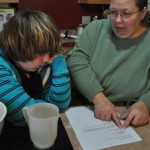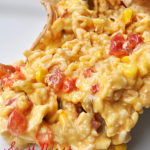It’s that time again, and it’s hard to believe we’ve now completed our first full official week of homeschooling! We did a lot of activities this week, as well as hitting the basics.
As I’ve mentioned in the past, we’ve chosen to write Jeffrey’s homeschool curriculum ourselves, using many resources from the internet, the library, and our own personal knowledge. We incorporate a lot of different methods, including the traditional (Math U See, Grammar books, etc) and the less traditional (learning fractions through baking, watching Good Eats and incorporating those ideas into science and math studies).
This week, we finished up reading Chocolate Fever, by Robert Kimmel Smith. It’s a book that really discusses moderation, in sorts. It’s a lighthearted story about a boy named Henry Green, who likes chocolate in EVERYTHING. Chocolate and pancakes? Yup. Chocolate and milk? Check. Chocolate and mashed potatoes? Totally. This kid is a choco-holic to the extreme, and one day, it kind of comes back to get him… he breaks out in little brown spots, in a case of CHOCOLATE FEVER! It’s a great book to teach kids about eating things in moderation, and how too much of a good thing can be a bad thing. It’s also a good book to discuss what to do when you’re afraid or nervous, or to discuss the effects of some foods on our bodies. It’s actually also a great book to read silently, or read before bed as a story together… the chapters are great bite-sized chunks. Definitely a good book for kids!
We also worked on a mini unit involving M&Ms. For our research skills, we learned that the company that makes M&Ms, Mars, also makes 3 Musketeers, Milky Way, all Wrigley and 5 gums, and even pet food! We also typed an email to Mars letting them know about our study of chocolate using M&Ms, as part of our typing practice.
M&Ms were a part of our study the entire week, and one of our fun projects involving M&Ms was a cool camouflage game! We took 10 of each color M&M- Red, Yellow, Orange, Green, Blue, and Brown, and poured them into a bowl with candy corn (which, we know are colored Orange, Yellow, and White).

Obviously, the Red, Green, Blue, and Brown M&Ms stand out a lot more than the Yellow and Orange! We didn’t tell Jeffrey what the plan was at all, or the lesson- we simply said “Pull out the first five M&Ms you see. Mark them on your graph, and toss them back in.” He did this, and each time would pull out the first five M&Ms. After 6 or 7 trials, we noticed that he had only pulled out 3 total orange or yellow, but over 40 total of the other colors! This was a great way to introduce that some animals and insects camouflage themselves to their surroundings by adopting the colors their surroundings, or sometimes even try to look like objects in their surroundings. We talked about chameleons, who change color to suit their surroundings, and Jeffrey brought up the examples of leaf bugs and stick bugs, whose bodies are very clear representations of their surroundings! It was a great discussion about how animals keep themselves from being hunted. Jeffrey also came up with examples like the arctic fox, who are white like the snow, and blend in with their surroundings. If Jeffrey were the hunter, and M&Ms were the prey, the yellow and orange did a pretty good job of protecting themselves!
Another science activity we played, using candy from the Mars company, was a Sink and Float game. Jeffrey considered the fillings of Milky Way, Milky Way Midnight, Snickers, Twix, M&Ms, and 3 Musketeers, and figured out whether they would sink, or float. Jeffrey hypothesized that 3 Musketeers would float because of the air filling (in the commercials, the bars are light and airy, and are shown to float even in the air, so it was a reasonable bet that, in water, the air trapped inside might make it float!) He believed that Milky Way and Milky Way Midnight would probably both sink- because the fillings are the same, if one sank, the other would, too. He thought that the heavy peanuts in Snickers could make it sink, but the light nougat could make it float, so he wasn’t sure how to hypothesize about the Snickers. The M&M, he thought, might float, because of it’s shape, and finally, he thought the cookie inside the Twix was light enough to make it float.
One by one, we dropped candies into the water.

Milky Way and Milky Way Midnight bot sank, just like Jeffrey thought. The 3 Musketeers floated, which he also accurately hypothesized. The nuts won out over nougat in the Snickers bar, because it sank like a rock, and even with it’s odd shape, the M&M sank, too. The Twix, though, that one made us laugh. Remember, Jeffrey thought it might float because of the light, airy shortbread cookie. Well, we dropped the Twix in, and it sank… but then it flipped over, so the cookie was on top! So, Jeffrey was kind of right- the cookie WAS airy enough to float, but the caramel and chocolate weighed it down.
We also incorporated M&Ms into a weights and measures activity, to practice using a balance for future science projects, and to talk about accuracy- sometimes, 24 M&Ms were too light, but 25 were too heavy, so it had to be somewhere in between the two measurements. We weighed M&Ms against many household objects, like a pencil, glue, tape, a cell phone, and a pair of scissors. We also figured out that if we knew how much one object weighed, and we added another object, we could take the total weight minus the weight of what we knew, to figure out the weight of the other object.

We discussed how, in ancient times, cacao beans were used as money in some parts of the world. One way that we ingrained this topic was by making monster cookies using M&Ms.

After we made the monster cookies, each of us dug into two of them, extracted the M&Ms, and used various equations to find out how much our cookies were worth based on our M&M “money.” It turned out that mom had the most valuable cookie, and I had the one with the least value… Jeffrey’s cookie was in between! Not only did we get a history lesson by discussing how currency around the world, and in different time periods, isn’t just like our money in America today, but we also worked on writing out a numeric equation based on a word or story problem, and we worked on measurements for cooking. A lot of the activities we do really incorporate several different subjects, to the point that sometimes it’s hard to say “This was our math lesson,” “this was our science lesson.” Many of our lessons are just that… “learning lessons.”

Some of our projects this week didn’t involve M&Ms at all, though. One of the particularly interesting topics we covered was based on part of the Field Museum’s curriculum regarding chocolate, which I found on their website. For this particular study, we discussed who grows chocolate, and how it affects their lives. We talked about the kind of life that the people who grow chocolate live, and how sometimes it can be a hard life. For example, we learned that many times, children younger than Jeffrey are recruited to work with the cacao trees and cut pods off of the trees, instead of going to school and studying. We also learned that sometimes, they don’t get paid much, but that some chocolate companies make sure that the people get paid fairly for their work, and give them ownership of the fields. Finally, we talked about what would happen if the world suddenly stopped eating chocolate (they would lose their jobs, and a lot of their lifestyle would be gone. Some of them could even have trouble affording food and shelter, and might die). We also talked about what would happen if the world suddenly started eating a lot more chocolate (they would have a lot more income, but also a lot more work to do. We would need more cacao trees, which also means we might have to cut down other trees to plant them).
We also discussed what basic needs people have, such as shelter, food, water, and clothing. To illustrate this, we gave Jeffrey the example that he would have to live in the park nearest our home. I asked him what he would do for food, clothing, and shelter. He mentioned that for food, he could always hunt squirrels or birds, fashioning arrows from sticks in the park. He also said that, since there are grills at the park, he could cook them on the grill using dried grass and stones to start the fire. He said that there were drinking fountains that would give him water, and a gazebo that could provide shelter from rain, or, he could rest at the top of the playground equipment, in a section that is covered and has the sides covered, as well. He carefully thought out important things like where he could use the restroom, and what clothing he might bring with him from home. He talked about how it was important to choose things that were cheap or free, and to choose things that were closely available. Obviously, if he was living in a park in Kansas, he would have to hunt squirrels, rather than polar bears. We talked about resource availability, and seeing what was closest to us.

We also discussed the Maya and the Aztec, and their connections to chocolate. They named it Theobroma Cacao, or, the Food of the Gods. They believed that their gods had left it here for them, and that they were to give it back to the gods when they returned to the earth. When the Spanish explorers came to their civilization, they believed that they were gods, and gave the chocolate to them, which later led to them bringing it back to Europe. We also discussed how chocolate was mostly for the wealthy, like the kings. I chose to skip the part about how, before a human sacrifice, the person being sacrificed would drink chocolate mixed with blood… ew! We also talked about how chocolate was almost always in liquid form during that time, and was consumed as a hot drink. We made our own Mayan Chocolate Drink, and determined that modern hot chocolate tasted MUCH better!
Jeffrey also spent some time researching the actual tree, and it’s growing conditions.

Did you know that monkeys are a big part of making sure we have plenty of cacao? They are one of the biggest spreaders and fertilizers of the cacao tree… a monkey will eat the cacao pods, digest them, and poop out cacao seeds, which later, can fertilize the seeds into a tree. Jeffrey liked to say this week that, when you eat a chocolate bar, you really should be thanking the monkeys for their poop.
We also learned that cacao trees would not produce their fruits without the help of a tiny little mosquito like insect, known as the midge. The midge is the sole pollinator of that species of trees, and without that midge there to pollinate it, the trees wouldn’t exist as we know them!
Another plus of homeschooling? Jeffrey is able to do all of this research in his pajamas and robe! He’s pretty happy about that…
We did have some beautiful weather at the beginning of the week, so we were able to spend some time playing outdoors.

And, for a little social time, Jeffrey was even able to jump into a one-time gymnastics class at a local gymnastics studio, which was a nice chance for some P.E.
We wrapped up the week with a little bit of review- by playing “Review Sorry!” In our house, one of the video games we all love is Sorry. We play it all the time, and it’s a big part of our lives. We adapted the game for review by saying that each person had to answer a review question correctly in order to draw a card and move their turn. The questions ranged from questions about the book we read this week, to requests to define vocabulary words, to working on describing objects in detail (we’re working on using descriptive words and expanding a single sentence into a more detailed paragraph). We also discussed facts, like the monkeys pooping out the seeds. Each week, we will take our old review questions, and add new ones in, and play a game, until, at the end of the unit, we have a whole flock of questions in our arsenal.
Homeschooling isn’t without it’s occasional tears or stress, but honestly, it’s one of the best decisions we’ve made for our family. We find that we are learning so many things, not just Jeffrey, but our entire family. As we’ve been going over math skills for Jeffrey, we’ve realized that mom and I are improving our math skills, as well. We really have worked together as a family to improve our minds, and we are all excited about what next week holds in our homeschooling adventure.
Oh, and for the record, Zach has school work to complete, too… see?

Have a good week, everyone!





I am loving all of your great ideas! One thing that appeals to me about homeschooling is the ability to teach a child in the way that they learn best, without doing only paper and pencil activities. It sounds like your year is off to a great start. I hope things continue to go smoothly for you 🙂
I love how nearly everything involved M&Ms. What fun!
Does’t homeschooling rock?!